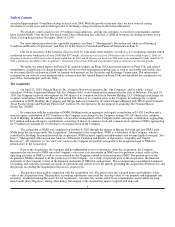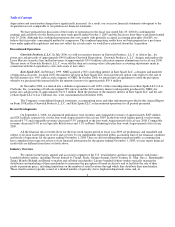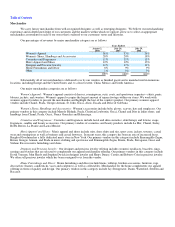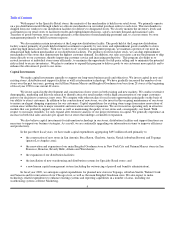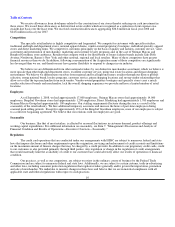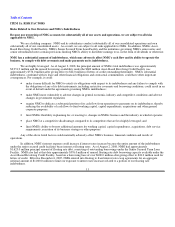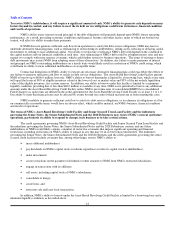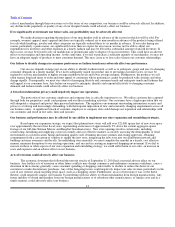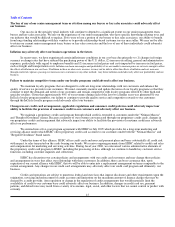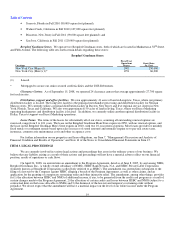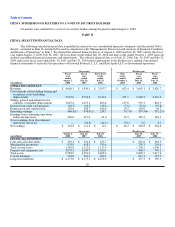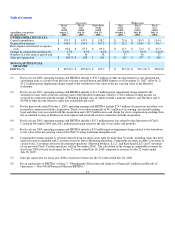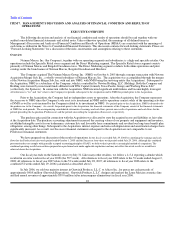Neiman Marcus 2007 Annual Report Download - page 16
Download and view the complete annual report
Please find page 16 of the 2007 Neiman Marcus annual report below. You can navigate through the pages in the report by either clicking on the pages listed below, or by using the keyword search tool below to find specific information within the annual report.
Table of Contents
Moreover, NMG's Asset-Based Revolving Credit Facility provides discretion to the agent bank acting on behalf of the
lenders to impose additional availability restrictions and other reserves, which could materially impair the amount of borrowings that
would otherwise be available to us. There can be no assurance that the agent bank will not impose such reserves or, were it to do so,
that the resulting impact of this action would not materially and adversely impair NMG's liquidity.
A breach of any of the restrictive covenants would result in a default under the Asset-Based Revolving Credit Facility and
Senior Secured Term Loan Facility. If any such default occurs, the lenders under the Asset-Based Revolving Credit Facility and
Senior Secured Term Loan Facility may elect to declare all outstanding borrowings under such facilities, together with accrued
interest and other fees, to be immediately due and payable, or enforce their security interest, any of which would result in an event of
default under NMG's Senior Notes and Senior Subordinated Notes and 2028 Debentures. The lenders would also have the right in
these circumstances to terminate any commitments they have to provide further borrowings.
The operating and financial restrictions and covenants in these debt agreements and any future financing agreements may
adversely affect NMG's ability to finance future operations or capital needs or to engage in other business activities.
Risks Related to Our Business and Industry
The specialty retail industry is highly competitive.
The specialty retail industry is highly competitive and fragmented. Competition is strong both to attract and sell to customers
and to establish relationships with, and obtain merchandise from, key vendors.
We compete for customers with specialty retailers, traditional and high-end department stores, national apparel chains,
vendor-owned proprietary boutiques, individual specialty apparel stores and direct marketing firms. We compete for customers
principally on the basis of quality and fashion, customer service, value, assortment and presentation of merchandise, marketing and
customer loyalty programs and, in the case of Neiman Marcus and Bergdorf Goodman, store ambiance. In our Specialty Retail
business, merchandise assortment is a critical competitive factor, and retail stores compete for exclusive, preferred and limited
distribution arrangements with key designers. Many of our competitors are larger than we are and have greater financial resources than
we do. In addition, certain designers from whom we source merchandise have established competing free-standing retail stores in the
same vicinity as our stores. If we fail to successfully compete for customers or merchandise, our business will suffer.
Deterioration in economic conditions could adversely affect our business.
The merchandise we sell consists in large part of luxury retail goods. The purchase of these goods by customers is
discretionary, and therefore highly dependent upon the level of consumer spending, particularly among affluent customers.
Accordingly, sales of these products may be adversely affected by an economic downturn, increases in consumer debt levels,
uncertainties regarding future economic prospects or a decline in consumer confidence. During an actual or perceived economic
downturn (as a result of increases in consumer debt levels, increases in interest rates, a tightening of consumer credit, uncertainties
regarding future economic performance and tax rates and policies, or a decline in consumer confidence, among other factors), fewer
customers may shop our stores and websites. As a result, we may be required to take significant additional markdowns and/or
increase our marketing and promotional expenses in response to the lower levels of demand for luxury goods.
An economic downturn in the United States generally or in any of the geographic areas in which we have stores, particularly
in Texas, California, Florida and the New York City metropolitan area, from which we derive a significant portion of our revenues,
could have a material adverse effect on our business and results of operations. In addition, promotional and/or prolonged periods of
deep discount pricing by our competitors could have a material adverse effect on our business.
We are dependent on our relationships with certain designers, vendors and other sources of merchandise.
Our relationships with established and emerging designers are a key factor in our position as a retailer of high-fashion
merchandise, and a substantial portion of our revenues is attributable to our sales of designer merchandise. Many of our key vendors
limit the number of retail channels they use to sell their merchandise and competition among luxury retailers to obtain and sell these
goods is intense. Our relationships with our designers have been a significant contributor to our past success. We have no guaranteed
supply arrangements with our principal merchandising sources. Accordingly, there can be no assurance that such sources will continue
to meet our quality, style and volume requirements. Moreover, nearly all of the brands of our top designers are sold by competing
retailers, and many of our top designers also have their own dedicated retail stores. If one or more of our top designers were to cease
providing us with adequate supplies of merchandise or, conversely, were to increase
13


